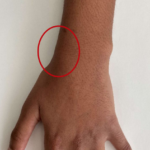What do you mean my scaphoid was already broken?
Were you playing soccer or basketball a few years ago and fell injuring your wrist? Maybe you just slipped or tripped and injured your wrist? Did you ignore the pain and swelling for the next few weeks as symptoms eventually subsided? Now, a few years have passed, and you have noticed that certain activities create pain in your wrist. These episodes of pain may be intermittent or longer-lasting. These scenarios are commonly associated with chronic scaphoid fractures (breaks).
The scaphoid is a bone that sits on the radial side of the wrist (same side as the thumb). This bone may break in different locations: the scaphoid tubercle, the distal pole, the waist, or the proximal pole. The distal pole fractures more commonly heal. When scaphoid fractures do not heal, they may eventually create pain and discomfort in the wrist. Individuals may notice intermittent or persistent wrist swelling and/or pain when performing activities. Radiographs (X-rays) help to characterize the location of the non-union (chronically non-healed area of broken bone) and also to identify any signs of decreased blood flow, carpal (wrist) instability, and/or arthritis.
 Picture 1: Radial aspect of the wrist circled.
Picture 1: Radial aspect of the wrist circled.
The blood supply of the scaphoid may be disrupted when the proximal pole of the scaphoid fractures. In this circumstance, radiographs may demonstrate sclerosis (increased bone mineral density) or fragmentation of the proximal pole. Magnetic resonance imaging (MRI) may also be ordered by your treating physician to evaluate for signs of decreased blood flow or avascular necrosis.
In some patients, chronic fracture of the scaphoid may lead to abnormal positioning of the carpal bones and/or arthritis. A term called scaphoid non-union advanced collapse (SNAC) arthropathy may be mentioned by your treating physician. When patients have SNAC arthropathy, they develop arthritis in varying locations of the wrist.
Nonoperative and operative treatment considerations include the location of the scaphoid fracture (area where the scaphoid is broken), the presence or absence of decreased blood flow, the position of the broken scaphoid fragments, and/or the presence or absence of arthritis.
Nonoperative treatment options in certain circumstances include rest, activity modification, over the counter medication, and/or intermittent splinting. Non-operative treatment for arthritis associated pain may include targeted cortisone injection.
Operative treatment for scaphoid nonunion varies based upon the circumstances. In patients with remaining blood flow to the scaphoid, your treating physician may discuss repair with or without structural bone graft. Patients with decreased blood flow to the scaphoid may require alternative treatment options. This includes vascularized bone grafting. In cases where arthritis has developed, treatment options such as partial wrist arthrodesis (fusion) with scaphoid excision or proximal row carpectomy may be discussed.
The decision regarding nonoperative versus operative treatment is complex and should be discussed with your treating physician.
Outcomes after surgical treatments vary and risks and benefits should be discussed in detail with your treating physician. Nonoperative treatment also carries risks and benefits which should be discussed with your treating physician.
Disclaimer: This information is not intended to covey, substitute or supplant any medical advice. In order to establish a treating relationship, please schedule and complete your visits with a licensed physician.
Copyright 2/6/2022 Tanay Amin, MD
Do not copy, distribute, or publish this article. Please contact Precision Hand and Orthopedic Surgery PLLC with regards to any inquiries or corrections.
